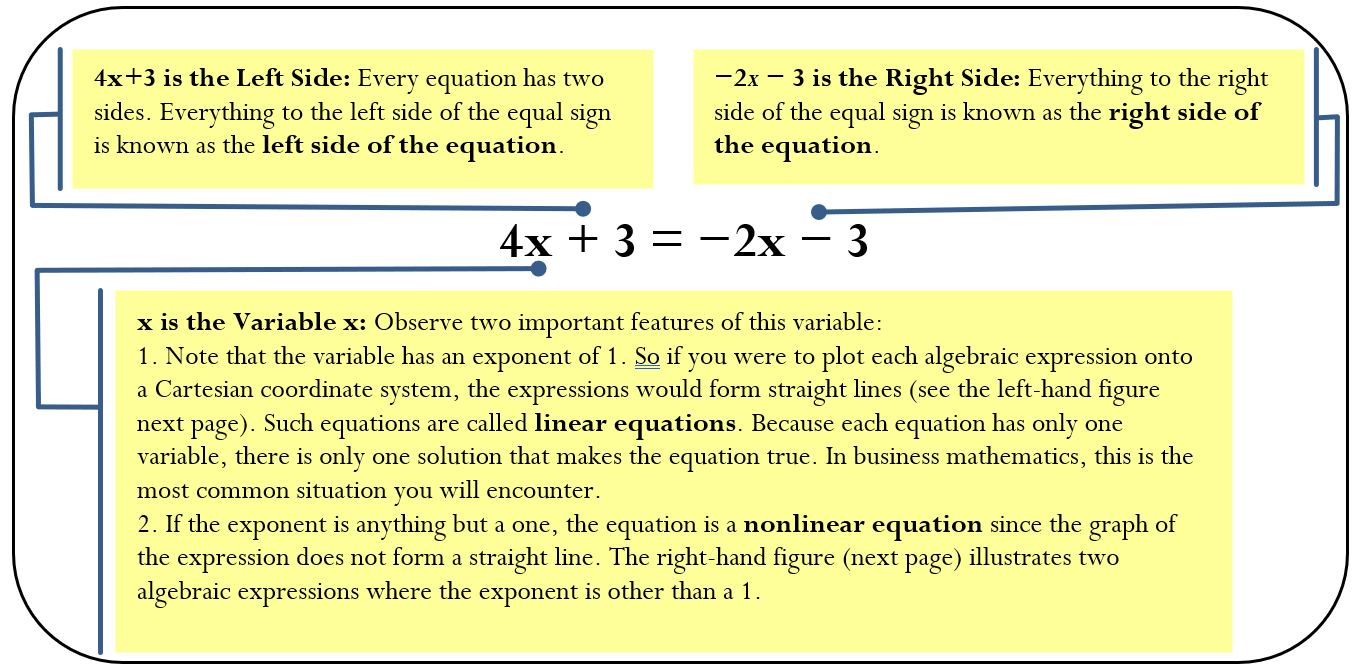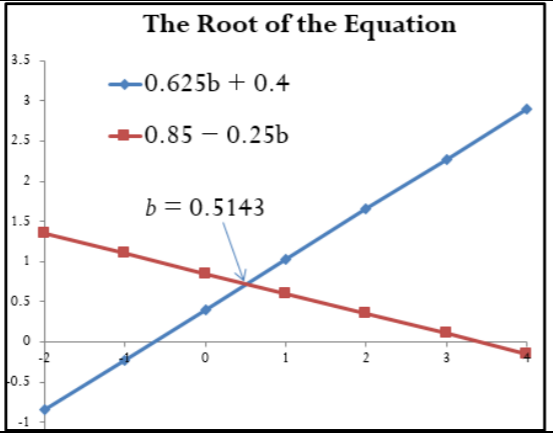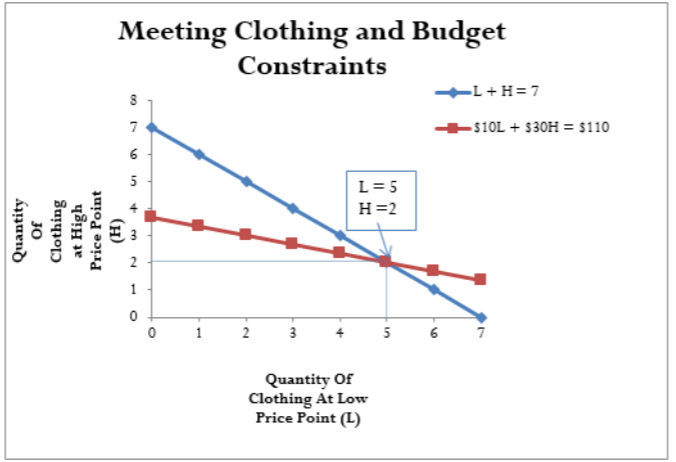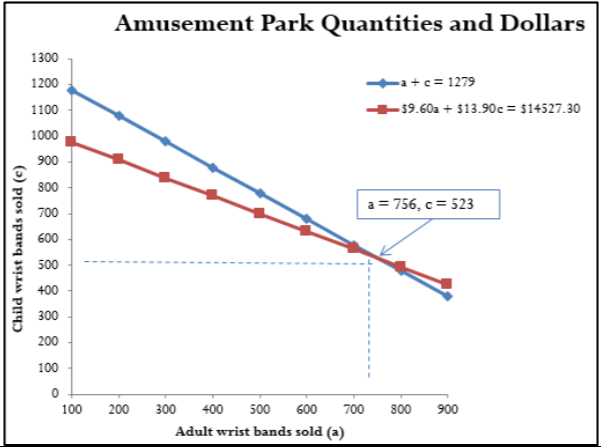2.5: Linear Equations - Manipulating and Solving (Solving the Puzzle)
- Page ID
- 22073
You are shopping at Old Navy for seven new outfits. The price points are $10 and $30. You really like the $30 outfits; however, your total budget can’t exceed $110. How do you spend $110 to acquire all the needed outfits without exceeding your budget while getting as many $30 items as possible?
This is a problem of linear equations, and it illustrates how you can use them to make an optimal decision. Let \(L\) represent the quantity of clothing at the low price point of $10, and \(H\) represent the quantity of clothing at the high price point of $30. This results in the following algebraic equations:
\[L+H=7 \text { (the total number of outfits you need) }\nonumber \]
\[\$ 10 L+\$ 30 H=\$ 110 \text { (your total budget) }\nonumber \]
By simultaneously solving these equations you can determine how many outfits at each price point you can purchase.
You will encounter many situations like this in your business career, for example, in making the best use of a manufacturer’s production capacity. Assume your company makes two products on the same production line and sells all its output. Each product contributes differently to your profitability, and each product takes a different amount of time to manufacture. What combination of each of these products should you make such that you operate your production line at capacity while also maximizing the profits earned? This section explores how to solve linear equations for unknown variables.
Understanding Equations
To manipulate algebraic equations and solve for unknown variables, you must first become familiar with some important language, including linear versus nonlinear equations and sides of the equation.

The goal in manipulating and solving a linear equation is to find a value for the unknown variable that makes the equation true. If you substitute a value of \(x = −1\) into the above example, the left-hand side of the equation equals the right-hand side of the equation (see Figure below). The value of \(x = −1\) is known as the root, or solution, to the linear equation.

Solving One Linear Equation with One Unknown Variable
In your study of solving linear equations, you need to start by manipulating a single equation to solve for a single unknown variable. Later in this section you will extend from this foundation to the solution of two linear equations with two unknowns.
How It Works
To determine the root of a linear equation with only one unknown variable, apply the following steps:
Step 1: Your first goal is to separate the terms containing the literal coefficient from the terms that only have numerical coefficients. Collect all of the terms with literal coefficients on only one side of the equation and collect all of the terms with only numerical coefficients on the other side of the equation. It does not matter which terms go on which side of the equation, so long as you separate them.
To move a term from one side of an equation to another, take the mathematical opposite of the term being moved and add it to both sides. For example, if you want to move the +3 in \(4x + 3 = −2x − 3\) from the left-hand side to the right-hand side, the mathematical opposite of +3 is −3. When you move a term, remember the cardinal rule: What you do to one side of an equation you must also do to the other side of the equation. Breaking this rule breaks the equality in the equation.
Step 2: Combine all like terms on each side and simplify the equation according to the rules of algebra.
Step 3: In the term containing the literal coefficient, reduce the numerical coefficient to a 1 by dividing both sides of the equation by the numerical coefficient.
Important Notes
When you are unsure whether your calculated root is accurate, an easy way to verify your answer is to take the original equation and substitute your root in place of the variable. If you have the correct root, the left-hand side of the equation equals the right-hand side of the equation. If you have an incorrect root, the two sides will be unequal. The inequality typically results from one of the three most common errors in algebraic manipulation:
- The rules of BEDMAS have been broken.
- The rules of algebra have been violated.
- What was done to one side of the equation was not done to the other side of the equation.
Things To Watch Out For
When you move a term from one side of the equation to another using multiplication or division, remember that this affects each and every term on both sides of the equation. To remove the \(x\) from the denominator in the following equation, multiply both sides of the equation by \(x\):
\(\dfrac{5}{x}+\dfrac{1}{x}=\dfrac{2}{x}+2\) becomes \(x\left(\dfrac{5}{x}+\dfrac{1}{x}\right)=\left(\dfrac{2}{x}+2\right) x\) which then becomes \(5+1=2+2 x\)
Multiplying every term on both sides by \(x\) maintains the equality.
Paths To Success
Negative numbers can cause some people a lot of grief. In moving terms from a particular side of the equation, many people prefer to avoid negative numerical coefficients in front of literal coefficients. Revisiting \(4x + 3 = −2x − 3\), you could move the \(4x\) from the left side to the right side by subtracting \(4x\) from both sides. However, on the right side this results in \(−6x\). The negative is easily overlooked or accidentally dropped in future steps. Instead, move the variable to the left side of the equation, yielding a positive coefficient of \(6x\).
Take the ongoing example in this section and solve it for \(x\): \(4x + 3 = −2x − 3\)
Solution
This is a linear equation since the exponent on the variable is 1. You are to solve the equation and find the root for \(x\).
What You Already Know
The equation has already been provided.
How You Will Get There
Apply the three steps for solving linear equations. To arrive at the root, you must follow the rules of algebra, BEDMAS, and equality.
Perform
Step 1: Move terms with literal coefficients to one side and terms with only numerical coefficients to the other side. Let’s collect the literal coefficient on the left-hand side of the equation. Move \(−2x\) to the left-hand side by placing \(+2x\) on both sides.
\[4x + 3 = −2x – 3 \nonumber \]
On the right-hand side, the \(−2x\) and \(+2x\) cancel out to zero.
\[4x + 3 (\bf{+ 2x}) = −2x − 3 (\bf{+ 2x}) \nonumber \]
Step 1 (continued): All of the terms with the literal coefficient are now on the left. Let’s move all of the terms containing only numerical coefficients to the right-hand side. Move the +3 to the right-hand side by placing −3 on both sides.
\[4x + 3 + 2x = −3 \nonumber \]
On the left-hand side, the +3 and −3 cancel out to zero.
\[4x + 3 + 2x (\bf{– 3}) = −3 (\bf{− 3}) \nonumber \]
Step 2: The terms are now separated. Combine like terms according to the rules of algebra.
\[4x + 2x = −3 – 3 \nonumber \]
Step 3: The term with the literal coefficient is being multiplied by the numerical coefficient of 6. Therefore, divide both sides by 6.
\[\bf{6x = −6} \nonumber \]
The left-hand side numerical coefficients will divide to 1. Resolve the numerical coefficients on the right-hand side.
\[\dfrac{6 x}{\bf{6}}=\dfrac{-6}{\bf{6}} \nonumber \]
This is the root of the equation.
\[x = −1 \nonumber \]
The root of the equation is \(x = −1\). To verify the accuracy of your manipulation, take the root of \(x = −1\) and substitute it into the original equation:
\[4(−1) + 3 = −2(−1) − 3\nonumber \]
\[−4 + 3 = 2 − 3\nonumber \]
\[−1 = −1\nonumber \]
The left-hand side equals the right-hand side, so the root is correct.
Solve the following equation for \(m\): \(\dfrac{3 m}{4}+2 m=4 m-15\)
Solution
This is a linear equation since the exponent on the variable is a 1. You are to solve the equation and find the root for \(m\).
What You Already Know
The equation has already been provided.
How You Will Get There
Simplify the equations first and then apply the three steps for solving linear equations. To arrive at the root you must follow the rules of algebra, BEDMAS, and equality. You can use an approach that avoids negatives.
Perform
First, simplify all fractions to make the equation easier to work with.
\[\dfrac{3 m}{4}+2 m=4 m-15 \nonumber \]
Still simplifying, collect like terms where possible.
\[(\bf{0.75m}) + 2m = 4m − 15 \nonumber \]
Step 1: Collect all terms with the literal coefficient on one side of the equation. Move all terms with literal coefficients to the right-hand side.
\[(\bf{2.75m })= 4m − 15 \nonumber \]
Step 1 (continued): Combine like terms and move all terms with only numerical coefficients to the left-hand side.
\[2.75m (\bf{− 2.75m}) = 4m − 15 (\bf{− 2.75m}) \nonumber \]
On the left-hand side, the \(+2.75m\) and \(−2.75m\) cancel each other out. Now move the numerical coefficients to the left-hand side.
\[(\bf{0}) = 4m − 15 (\bf{− 2.75m}) \nonumber \]
On the right-hand side, the −15 and +15 cancel each other out.
\[0 (\bf{+ 15 })= 4m − 15 − 2.75m (\bf{+ 15}) \nonumber \]
Step 2: Combine like terms on each side.
\[0 (\bf{+ 15}) = 4m − 2.75m \nonumber \]
Step 3: Divide both sides by the numerical coefficient that accompanies the literal coefficient.
\[\bf{15 = 1.25m} \nonumber \]
Simplify.
\[\dfrac{15}{\bf{1.25}}=\dfrac{1.25 m}{\bf{1.25}} \nonumber \]
This is the root of the equation.
\[12=m\nonumber \]
The root of the equation is \(m = 12\).
This makes both sides of the equation,
\(\dfrac{3 m}{4}+2 m\) and \(4 m-15\), equal 33.

Solve the following equation for \(b\) and round your answer to four decimals: \(\dfrac{5}{8} b+\dfrac{2}{5}=\dfrac{17}{20}-\dfrac{b}{4}\)
Solution
This is a linear equation since the exponent on the variable is a 1. You are to solve the equation and find the root for \(b\).
What You Already Know
The equation has already been provided. Although you could attempt to clear each and every fraction or try to find a common denominator, recall that you can eliminate fractions by converting them to decimals.
How You Will Get There
Simplify the fractions into decimal form. Then apply the three steps for solving linear equations. To arrive at the root, you must follow the rules of algebra, BEDMAS, and equality.
Perform
Simplify the fractions and convert to decimals.
\[\dfrac{5}{8} b+\dfrac{2}{5}=\dfrac{17}{20}-\dfrac{b}{4} \nonumber \]
Step 1: Move the literal coefficient terms to the left-hand side.
\[(\bf{0.625})b (\bf{+ 0.4}) = (\bf{0.85 − 0.25})b \nonumber \]
The literal coefficients on the right-hand side cancel each other out.
\[0.625b + 0.4 + (\bf{0.25b}) = 0.85 − 0.25b + (\bf{0.25b}) \nonumber \]
Move the numerical coefficient terms to the right-hand side.
\[0.625b + 0.4 + 0.25b = 0.85 \nonumber \]
The numerical coefficients on the left-hand side cancel each other out.
\[0.625b + 0.4 +0.25b (\bf{− 0.4}) = 0.85 (\bf{− 0.4}) \nonumber \]
Step 2: Combine like terms on each side.
\[0.625b + 0.25b = 0.85 − 0.4\nonumber \]
Step 3: Divide both sides by the numerical coefficient that accompanies the literal coefficient.
\[\bf{0.875b = 0.45} \nonumber \]
Simplify.
\[\dfrac{0.875 b}{\bf{0.875}}=\dfrac{0.45}{\bf{0.875}} \nonumber \]
Round to four decimals as instructed.
\[b = 0.514285 \nonumber \]
This is the root.
\[b = 0.5143 \nonumber \]
The root of the equation, rounded to four decimals, is \(b = 0.5143\).

Solving Two Linear Equations with Two Unknown Variables
The manipulation process you have just practiced works well for solving one linear equation with one variable. But what happens if you need to solve two linear equations with two variables simultaneously? Remember when you were at Old Navy purchasing seven outfits earlier in this chapter (equation 1)? You needed to stay within a pricing budget (equation 2). Each equation had two unknown variables representing the number of lower-priced and higher-priced outfits.
The goal is to reduce two equations with two unknowns into a single linear equation with one unknown. Once this transformation is complete, you then identify the unknown variable by applying the three-step procedure for solving one linear equation, as just discussed.
When you work with two linear equations with two unknowns, the rules of algebra permit the following two manipulations:
- What you do to one side of the equation must be done to the other side of the equation to maintain the equality. Therefore, you can multiply or divide any equation by any number without changing the root of the equation. For example, if you multiply all terms of \(x + y = 2\) by 2 on both sides, resulting in \(2x + 2y = 4\), the equality of the equation remains unchanged and the same roots exist.
- Terms that are on the same side of an equation can be added and subtracted between equations by combining like terms. Each of the two equations has a left side and right side. This rule permits taking the left side of the first equation and either adding or subtracting like terms on the left side of the second equation. When you perform this action, remember the first rule above. If you add the left sides of the equations together, you then must add the right side of both equations together to maintain equality.
How It Works
Follow these steps to solve two linear equations with two unknown variables:
Step 1: Write the two equations one above the other, vertically lining up terms that have the same literal coefficients and terms that have only the numerical coefficient. If necessary, the equations may need to be manipulated such that all of the literal coefficients are on one side with the numerical coefficients on the other side.
Step 2: Examine your two equations. Through multiplication or division, make the numerical coefficient on one of the terms containing a literal coefficient exactly equal to its counterpart in the other equation.
Step 3: Add or subtract the two equations as needed so as to eliminate the identical term from both equations.
Step 4: In the new equation, solve for the last literal coefficient.
Step 5: Substitute the root of the known literal coefficient into either of the two original equations. If one of the equations takes on a simpler structure, pick that equation.
Step 6: Solve your chosen equation for the other literal coefficient.
Paths To Success
Sometimes it is unclear exactly how you need to multiply or divide the equations to make two of the terms identical. For example, assume the following two equations:
\[4.9x + 1.5y = 38.3\nonumber \]
\[2.7x − 8.6y = 17.8\nonumber \]
If the goal is to make the terms containing the literal coefficient \(x\) identical, there are two alternative solutions:
- Take the larger numerical coefficient for \(x\) and divide it by the smaller numerical coefficient. The resulting number is the factor for multiplying the equation containing the smaller numerical coefficient. In this case, \(4.9 \div 2.7 =1 . \overline{814}\). Multiply all terms in the second equation by \(1 . \overline{814}\) to make the numerical coefficients for \(x\) equal to each other, resulting in this pair of equations:
\[4.9x + 1.5y = 38.3\nonumber \]
\[4.9 x-15.6 \overline{074} y=32.3 \overline{037} \text { (every term multiplied by } 1 . \overline{814})\nonumber \]
- Take the first equation and multiply it by the numerical coefficient in the second equation. Then take the second equation and multiply it by the numerical coefficient in the first equation. In this case, multiply all terms in the first equation by 2.7. Then multiply all terms in the second equation by 4.9.
\[13.23 x+4.05 y=103.41 \text { (every term multiplied by } 2.7)\nonumber \]
\[13.23 x-42.14 y=87.22 \text { (every term multiplied by 4.9) }\nonumber \]
Note that both approaches successfully result in both equations having the same numerical coefficient in front of the literal coefficient \(x\).
Paths To Success
Ultimately, every pairing of linear equations with two unknowns can be converted into a single equation through substitution. To make the conversion, do the following:
- Solve either equation for one of the unknown variables.
- Take the resulting algebraic expression and substitute it into the other equation. This new equation is solvable for one of the unknown variables.
- Substitute your newfound variable into one of the original equations to determine the value for the other unknown variable.
Take the following two equations:
\[a + b = 4 \quad \quad 2a + b = 6\nonumber \]
- Solving the first equation for a results in \(a = 4 - b\).
- Substituting the expression for a into the second equation and solving for b results in \(2(4 - b) + b = 6\), which solves as \(b = 2\).
- Finally, substituting the root of b into the first equation to calculate a gives \(a + 2 = 4\) resulting in \(a = 2\). Therefore, the roots of these two equations are \(a = 2\) and \(b = 2\).
Recall from the section opener that in shopping for outfits there are two price points of $10 and $30, your budget is $110, and that you need seven articles of clothing. The equations below represent these conditions. Identify how many low-priced outfits (\(L\)) and high-priced outfits (\(H\)) you can purchase.
\[L + H = 7 \text{ } \$10L + \$30H = $110\nonumber \]
Solution
You need to determine the quantity of low-price-point items, or \(L\), and high-price-point items, or \(H\), that are within your limited budget. Note that the exponents on the variables are 1 and that there are two unknowns. So there are two linear equations with two unknowns.
What You Already Know
You require seven articles of clothing and only have a budget of $110. The equations express the relationships of quantity and budget.
How You Will Get There
Apply the six-step procedure for solving two linear equations with two unknowns.
Step 1:
Write the equations one above the other and line them up.
\[\begin{array} {lllll} {L} & + &{H}& = &{7}\\ {\$10L} & + &{\$30H}& = &{\$110}\\ \end{array} \nonumber \]
Step 2:
Multiply all terms in the first equation by 10 so that \(L\) has the same numerical coefficient in both equations.
\[\begin{array} {lllll} {10L} & + &{10H}& = &{70}\\ {\$10L} & + &{\$30H}& = &{\$110}\\ \end{array} \nonumber \]
Step 3:
Subtract the equations by subtracting all terms on both sides.
\[\begin{array} {llllll} { } &{10L} & + &{10H}& = &{70}\\ {\text{subtract}} &{\$10L} & + &{\$30H}& = &{\$110}\\{ } &{ } & - &{\$20H}& = &{−\$40}\\ \end{array} \nonumber \]
Step 4:
Solve for \(H\) by dividing both sides by −20.
\[\dfrac{-\$ 20 H}{-\$ 20}=\dfrac{-\$ 40}{-\$ 20} \quad H=2 \nonumber \]
Step 5:
Substitute the known value for \(H\) into one of the original equations. The first equation is simple, so choose that one.
\[\begin{array} {lllll} {L} & + &{H}& = &{7}\\ {L} & + &{2}& = &{7}\\ \end{array} \nonumber \]
Step 6:
Solve for \(L\) by subtracting 2 from both sides. You now have the roots for \(L\) and \(H\).
\[\begin{array} {lllllllll} {L}&+&{2} & - &{2}& = &{7}&-&{2}\\ { } & { } &{ } & { } &{L}& = &{5} & { } & { }\\ \end{array} \nonumber \]
You can purchase five articles of clothing at the low price point and two articles of clothing at the high price point. This allows you to purchase seven articles of clothing and stay within your budget of $110.

Paths To Success
One of the most difficult areas of mathematics involves translating words into mathematical symbols and operations. To assist in this translation, the table below lists some common language and the mathematical symbol that is typically associated with the word or phrase.
| Language | Math Symbol | ||
|---|---|---|---|
|
Sum Addition |
In addition to In excess |
Increased by Plus |
+ |
|
Subtract Decreased by Diminished by |
Less Minus |
Difference Reduced by |
- |
|
Multiplied by Times |
Percentage of |
Product of Of |
× |
|
Divide Division |
Divisible Quotient |
Per | ÷ |
|
Becomes Is/Was/Were |
Will be |
Results in Totals |
= |
| More than | Greater than | > | |
| Less than | Lower than | < | |
| Greater than or equal to | ≥ | ||
| Less than or equal to | ≤ | ||
| Not equal to | ≠ | ||
Tinkertown Family Fun Park charges $15 for a child wrist band and $10.50 for an adult wrist band. On a warm summer day, the amusement park had total wrist band revenue of $15,783 from sales of 1,279 wrist bands. How many adult and child wrist bands did the park sell that day?
Solution
You need the number of both adult and child wrist bands sold on the given day. Therefore, you must identify two unknowns.
What You Already Know
The price of the wrist bands,total quantity, and sales are known:
Child wrist band price = $15
Adult wrist band price = $10.50
Total revenue = $15,783
Total unit sales = 1,279
The quantity of adult wrist bands sold and the quantity of child wrist bands sold are unknown:
Adult wrist bands quantity = \(a\)
Child wrist bands quantity = \(c\)
How You Will Get There
- Work with the quantities first. Calculate the total unit sales by adding the number of adult wrist bands to the number of child wrist bands:
\[\# \text { of adult wrist bands }+\# \text { of child wrist bands }=\text { total unit sales } \nonumber \]
\[a + c = 1,279\nonumber \]
- Now consider the dollar figures. Total revenue for any company is calculated as unit price multiplied by units sold. In this case, you must sum the revenue from two products to get the total revenue.
\[\text { Total adult revenue }+\text { Total child revenue }=\text { Total revenue }\nonumber \]
\[\text { (Adult price } \times \text { Adult guantity })+\text { (Child price } \times \text { Child quantity) }=\text { Total revenue }\nonumber \]
\[\$ 10.50 a+\$ 15 c=\$ 15,783\nonumber \]
- Apply the six-step procedure for solving two linear equations with two unknowns.
Perform
Step 1:
Write the equations one above the other and line them up.
\[\begin{array} {lllll} {a} & + &{c}& = &{1,279}\\ {\$10.50a} & + &{\$15c}& = &{\$15,783}\\ \end{array} \nonumber \]
Step 2:
Multiply all terms in the first equation by 10.5, resulting in a having the same numerical coefficient in both equations.
\[\begin{array} {lllll} {\bf{10.50} a} & + &{\bf{10.50} c} & = & {\bf{13,429.50}} \\ {\$10.50a} & + &{\$15c}& = &{\$15,783}\\ \end{array} \nonumber \]
Step 3:
Subtract the equations by subtracting all terms on both sides.
\[\begin{array} {llllll} { } & {\bf{10.50} a} & + &{\bf{10.50} c} & = & {\bf{13,429.50}} \\ {\text{Subtract}} & {\underline{\$10.50a}} & {\underline{+}} &{\underline{\$15c}} & {\underline{=}} &{\underline{\$15,783}}\\ { } & { } & { } & {\bf{-4.5c}} & {\bf{=}} & {\bf{-2,353.50}} \\ \end{array} \nonumber \]
Step 4:
Solve for \(c\) by dividing both sides by −4.5.
\[\dfrac{-4.5 c}{-4.5}=\dfrac{-2,353.50}{-4.5} \quad c=523 \nonumber \]
Step 5:
Substitute the known value for \(c\) into one of the original equations. The first equation is simple, so choose that one.
\[\begin{array} {lllll} {a} & + & {c} & = &{1,279} \\ {a} & + & {\bf{523}} & = &{1,279}\\ \end{array} \nonumber \]
Step 6:
Solve for a by subtracting 523 from both sides. You now have the roots for \(a\) and \(c\).
\[\begin{aligned} a+523 \bf{-523} &=1,279 \bf{-523} \\ a &=756 \end{aligned} \nonumber \]
Tinkertown Family Fun Park sold 523 child wrist bands and 756 adult wrist bands.



